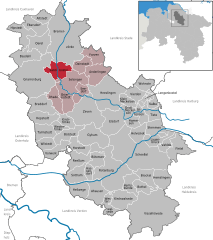Sandbostel
| Sandbostel | ||
|---|---|---|
| ||
 Sandbostel | ||
Location of Sandbostel within Rotenburg (Wümme) district 
 | ||
| Coordinates: 53°24′34″N 09°07′50″E / 53.40944°N 9.13056°ECoordinates: 53°24′34″N 09°07′50″E / 53.40944°N 9.13056°E | ||
| Country | Germany | |
| State | Lower Saxony | |
| District | Rotenburg (Wümme) | |
| Municipal assoc. | Selsingen | |
| Subdivisions | 4 | |
| Government | ||
| • Mayor | Johann Gerken (WGO) | |
| Area | ||
| • Total | 31.54 km2 (12.18 sq mi) | |
| Elevation | 8 m (26 ft) | |
| Population (2012-12-31)[1] | ||
| • Total | 804 | |
| • Density | 25/km2 (66/sq mi) | |
| Time zone | CET/CEST (UTC+1/+2) | |
| Postal codes | 27446 | |
| Dialling codes | 04284, 04764 | |
| Vehicle registration | ROW | |
| Website | www.selsingen.de | |
Sandbostel is a municipality in Lower Saxony (Niedersachsen) in northwestern Germany, 43 km north-east of Bremen, 60 km west of Hamburg. Coordinates: 53° 25′ N, 9° 8′ E. Population: 816 (2005)
Sandbostel belonged to the Prince-Archbishopric of Bremen, established in 1180. In 1648 the Prince-Archbishopric was transformed into the Duchy of Bremen, which was first ruled in personal union by the Swedish Crown - interrupted by a Danish occupation (1712–1715) - and from 1715 on by the Hanoverian Crown. In 1807 the ephemeric Kingdom of Westphalia annexed the Duchy, before France annexed it in 1810. In 1813 the Duchy was restored to the Electorate of Hanover, which - after its upgrade to the Kingdom of Hanover in 1814 - incorporated the Duchy in a real union and the Ducal territory, including Sandbostel, became part of the new Stade Region, established in 1823.
In 1932 in the Great Depression the Lutheran Church of the State of Hanover opened a camp for workless singles, employed in public works (roadworks, amelioration) near Sandbostel.
In 1939 the Sandbostel camp, meanwhile usurped by the Nazi trade union Reichsarbeitsdienst, was converted into the Prisoner-of-war camp Stalag X-B and a camp of internment for civilian enemy aliens. Until 1945 about a million inmates passed through the camp, with about 46,000 perished. A couple of the original camp buildings still exist in the commercial estate Immenheim. The cemetery in which several thousand prisoners are buried in mass graves is just outside the town. There is a memorial to them.
